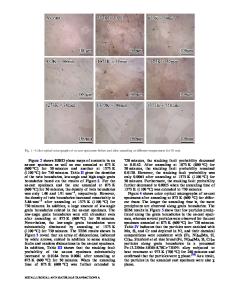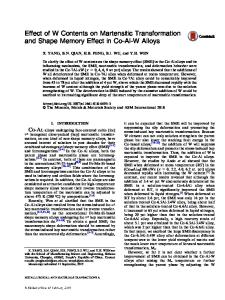Understanding indentation-induced two-way shape memory effect
- PDF / 297,900 Bytes
- 5 Pages / 585 x 783 pts Page_size
- 67 Downloads / 1,064 Views
David S. Grummon Department of Chemical Engineering and Materials Science, Michigan State University, East Lansing, Michigan 48824 (Received 8 April 2007; accepted 19 June 2007)
Spherical indents in NiTi shape memory alloys can have reversible depth change: deeper depth in the martensitic phase at low temperature and shallower depth in the austenitic phase at high temperature. This is the indentation-induced two-way shape memory effect. After polishing the indents, two-way reversible surface protrusions can occur on the shape memory alloy surfaces upon heating and cooling. The height of the surface protrusion is about the same as the depth of the reversible indent. Further polishing reduces the height of the surface protrusion, which disappears completely when the polished depth is about the length of the contact radius. By comparing finite element analysis and experimental data, we show that the depth at which a protrusion disappears is close to the 10% strain boundary. This suggests that slip-plasticity is responsible for the observed indentation-induced two-way shape memory effect.
I. INTRODUCTION
Shape memory and superelastic effects are shown to exist under complex contact loading conditions.1–6 For example, spherical and pyramidal indents in the martensitic phase of NiTi shape memory alloys can recover upon heating to the austenitic phase.2 Spherical indents can recover completely if indentation depth is less than a certain value (contact radius is about 25% of the indenter radius).5 Berkovich indents can only recover 45% of their depths because slip-plasticity is inevitably introduced in sharp indentations,2 consistent with the current understanding that dislocations from slip-plasticity are, in general, detrimental to the shape memory effect.6 For the indentation-induced superelastic effect, indents in the austenitic phase of NiTi alloys recover upon unloading.1 Furthermore, the indentation-induced shape memory and superelastic effects can occur at the micro- and nanometer length scales, opening up many opportunities for potential applications. Recently, we have shown that spherical indents in a
a)
Address all correspondence to this author. e-mail: [email protected] b) This author was an editor of this journal during the review and decision stage. For the JMR policy on review and publication of manuscripts authored by editors, please refer to http:// www.mrs.org/jmr_policy DOI: 10.1557/JMR.2007.0356 J. Mater. Res., Vol. 22, No. 10, Oct 2007
http://journals.cambridge.org
Downloaded: 17 Jun 2014
NiTi shape memory alloy can also exhibit two-way shape memory effect (TWSME).7 The indent is deeper in the martensitic phase at low temperature and becomes shallower in the austenitic phase at high temperature. The temperature hysteresis of the phase transformations is about 60 K. After the indent is removed by polishing to restore a flat surface, or “planarization,” the reversible indent transforms to a reversible surface protrusion that appears with heating to the austenitic phase and disappears with cooling
Data Loading...











